
| Home | FAQs | Rules | Archives | Articles | Jobs | Links | KWHSS | OSCAR | SCA.org |
A Grammar of Blazonry
or
Master Bruce's Guide to Excruciatingly Correct Blazon
© 1988 Bruce Miller
Of all the talents needed by a herald of the Society, blazoning a submitter's device is perhaps the one most mysterious to the submitter. Suddenly, the herald seems to be spouting a foreign language, one only remotely resembling English -- and, amazingly, putting into words the picture on the submission form.
A blazon is much more than a simple description of a device, however. To quote Woodward, to blazon a device is to verbally describe it "in heraldic terminology so exactly that anyone acquainted with the language of armory may be able accurately to depict it from its concise description." This is the essence of blazonry: the ability to reconstruct the emblazon. A blazon needs to be, not just correct, but full and correct: it is not enough to say just "lion" when the lion is dormant.
In many ways, therefore, blazonry is like a foreign language: it has vocabulary and grammar, both of which contribute to the meaning of a blazon. Just as, in Spanish class, learning all the -ir verbs was hard but learning how to conjugate them took only a week, so it is in heraldry. Vocabulary is not something that can be learned from a single article: it takes practice, a willingness to search for new phrases (particularly period phrases), and the ability to learn from mistakes. In this article I will concentrate on the grammar of blazonry, which is the internal logical structure of the blazon.
A standardized form of blazonry began to develop in the 13th Century. Prior to this, blazons were simple descriptions of armory, with few details. Neither was there any particular order to the blazon: for example, while in standard blazonry, the field is mentioned first, in many early blazons the field might be mentioned last.
According to Gerald Brault's Early Blazon, the standardization of blazon had two reasons. Partially it came from the realization that wrong blazons had legal consequences: if a herald were to record in a roll of arms that, e.g., de Montfort's lion is Or instead of argent, then some reader could innocently usurp the real arms of de Montfort while thinking he was sufficiently different. (The problem is much more acute in Society heraldry: we have to deal with a great many more armories.)
The main reason for this standardization, however, was simply to make the heralds' job easier. Most working heralds kept rolls of arms in their heads, as it's rather hard to carry an ordinary on the battlefield. They needed some mnemonic system to help them learn and memorize many devices. They employed default postures and placements whenever possible: if an eagle is always displayed, that's one less detail to worry about. But along about 1250, medieval heralds developed the idea of the heraldic phrase: this specified the natures of certain charges, lines of division, postures, and placements. The purpose was to have the charges, tinctures, and other such details blazoned "in such an order that there could be no doubt as to their arrangement, in the shield and in relation to one another." (Boutell)
The grammar of blazon used in the SCA follows, with minor variations, the standardized form:
(1) Field.
(2) Primary charges.
(3) Secondary charges immediately around (2).
(4) Tertiary charges on (2) or (3).
(5) Peripheral secondary charges.
(6) Tertiary charges on (5).
(7) Brisures.
(8) Augmentations.
Charges are blazoned in the above order; this order reflects the visual importance of each group of charges. Let us expand on these categories:
Field. If the device consists solely of a field, the blazon is simple. If the field is plain, the tincture should be given: Ermine (Brittany), or Gules (d'Albret).
If the field is parted, the type of division, and any complex lines of partition, must be specified along with the component tinctures. The early forms of English blazon used the phrase "Party per X", where X was one of the ordinaries -- Party per fess, for instance. (Scots blazon still use a similar form.) The word "party" was quickly dropped, as it was intuitively obvious; we would simply use Per fess.
This is followed by the complex line, if one is used, and the tinctures follow that. Field treatments (e.g. masoned) are considered part of the tincture, and are blazoned along with it.
In specifying the tinctures used, the chief portion of the field is blazoned first. If both portions of the
field are equally "in chief", the dexter portion of the field comes first. Thus in fig.1, the field is divided
diagonally (as a bend), the white portion is on top, and the line is embattled; this is blazoned Per bend
embattled argent and sable. A vertical division has both portions equally in chief, so the dexter
portion is blazoned first: then comes the complex line (wavy, this time), and then the fields and their
treatment. Thus fig.2 would be blazoned Per
pale wavy argent fretty sable, and sable.

|

|
Figure 1 |
Figure 2 |
Most of the simple, two-part field divisions can be multiplied to form multi-part fields. For instance,
Per pale can be multiplied into Paly (fig.3); Per bend into Bendy; etc. These are blazoned in the same
order as their parent forms. Note that they all have an even number of divisions -- usually six or eight,
but other numbers can be specified. If there are an odd number of divisions, the design is not blazoned
as a field, but as a group of ordinaries -- i.e. in fig.3 we see the distinction between Paly argent and
sable and Argent, three palets sable. The amount of heraldic difference is small-to-negligible, but the
distinction is still preserved in the blazon.
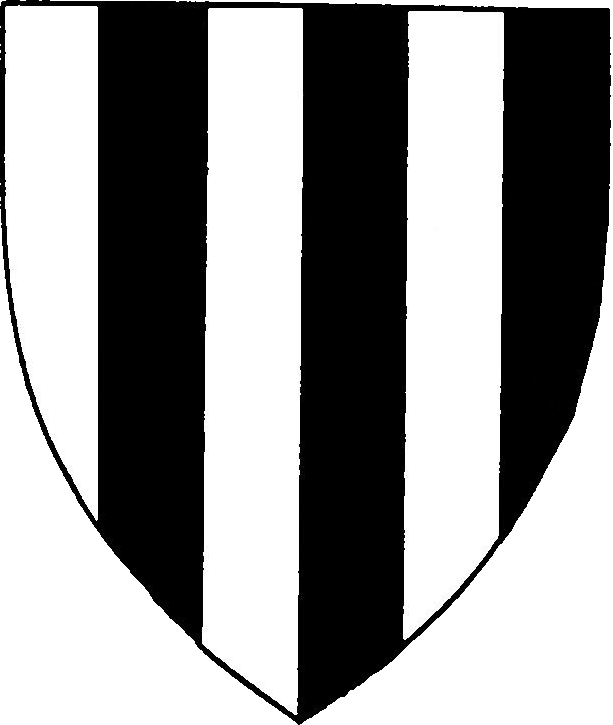
|

|
Paly argent and sable |
Figure 3 |
Argent, three palets sable |
If there are several charges in any one group, they are blazoned in order from the field up; from the
center out; from chief to base; and from dexter to sinister -- the first rule that applies to a given device.
See fig.4 for examples of each hierarchy of blazon. (This applies as well to other groups of charges.
For instance, in the arms Or, a bend between a blivet and a hufnagel gules, the blivet is in chief.)
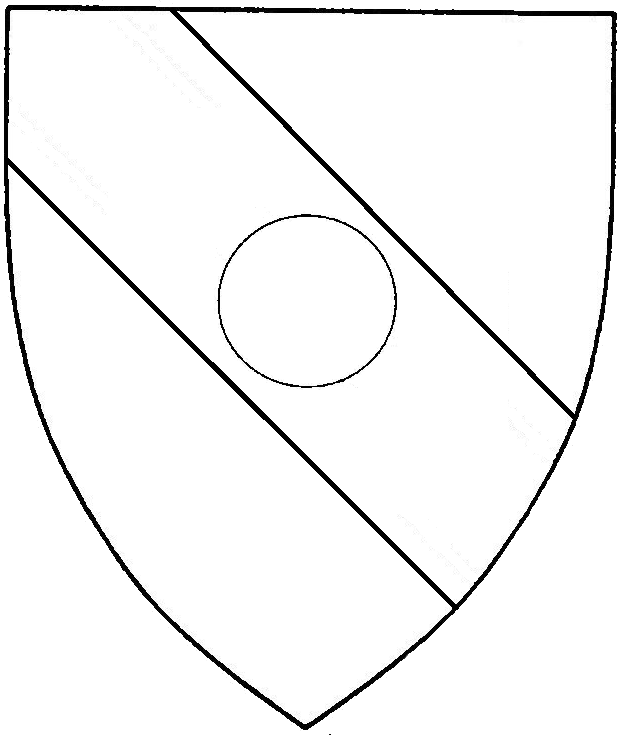
|
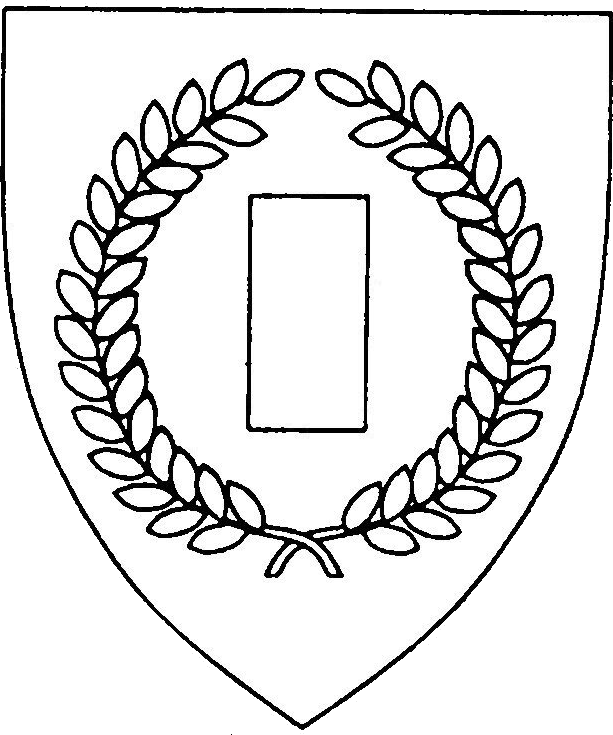
|
From the field up: |
Figure 4 |
From the center out: |
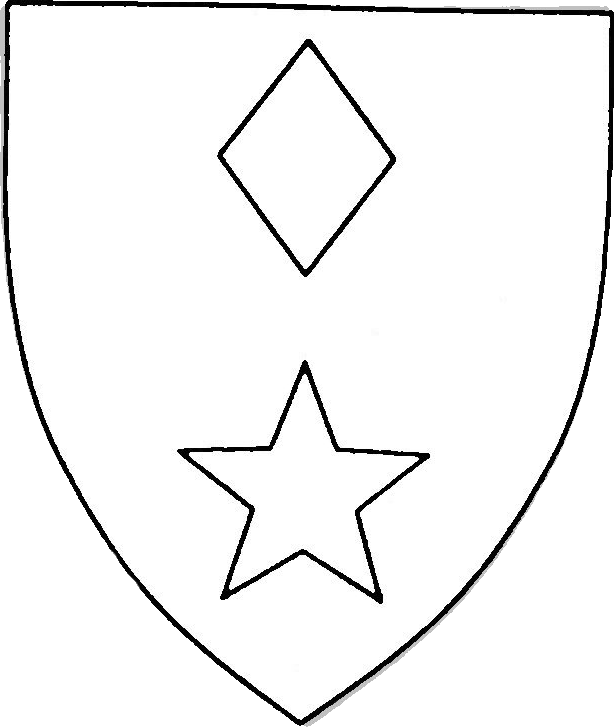
|

|
From chief to base: |
From dexter to sinister: |
Secondary and tertiary charges. These are blazoned after the primary charges for historical reasons. In the 12th and 13th Centuries, secondaries and tertiaries were added to a device as a form of cadency. If a blazon were recorded for the main branch of the family, the added charges could simply be appended to the blazon as written. Thus, the arms of Grandison, Paly argent and azure, a bend gules, could be easily modified for cadet branches by adding the phrase and on the bend three eagles Or (or three escallops Or, or three buckles Or, depending on the branch of the family).
Peripheral secondary charges. This includes the chief, the bordure and the canton, among others. Though ordinaries, they were not first in the blazon, for the same reason given above: they were often additions to the device, and medieval heralds did not have word processors to permit easy amendments to recorded blazons.
If both a bordure and a chief are used, the bordure is blazoned first; the chief then follows the bordure. Cantons are blazoned last of all. If they have tertiary charges, those are blazoned along with the secondary: i.e. first the bordure, then the tertiaries on the bordure, then the chief, then the tertiaries on the chief. (More than that is probably too busy to be registered, but one never knows)
Brisures (marks of cadency) and augmentations. Both are becoming more common in SCA heraldry.
Again, as they are additions to a basic coat, they are mentioned last in the blazon. Brisures come
before augmentations to insure (a) that Daddy's augmented coat is not cadenced, complete with
augmentation, by Junior, and also (b) that Junior's cadenced coat can, if he's earned one, bear an
augmentation.
In describing a charge or group of charges, the details are given in the following order:
(1) Number of charges. (If it's a group of one, use "a"; otherwise use the number, "two" or whatever.)
(2) Type of charge. Obviously, we need to identify the charge. Is it a lion, a mullet, a falcon? But we must also specify variant of type, if appropriate: is it a cross, or a cross couped? A bow, or a crossbow? A sword, or a seax?
(3) Posture of charge. This applies mostly to animate charges -- is the lion rampant, or sejant, or couchant? Is it guardant? Etc. But it can also apply to inanimate charges that are inverted, or turned to sinister.
(4) Treatment of charge. This includes such things as embattled, couped, etc. Usually such details are classed as variants of type, under #2 above, but not always. If the posture of the charge needs to be blazoned, the treatment of the charge comes afterward. There's a difference between an arm bendwise couped and an arm couped bendwise (fig.5).

|
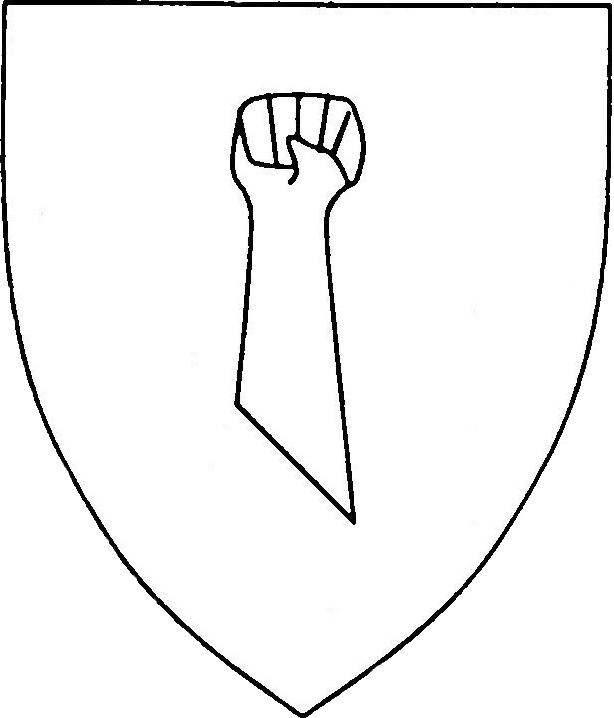
|
An arm bendwise couped |
Figure 5 |
An arm couped bendwise |
(5) Tincture of charge. In general, charges are blazoned in the same way as the field. If the blazon gives several consecutive charges of the same tincture, the tincture is blazoned only for the last charge; it is assumed to apply to all the preceding unspecified charges. Thus, for Argent, a saltire between four mullets, a chief gules, the saltire and the mullets are gules, as well as the chief. Had the mullets been a different tincture, we would have had to repeat the word gules in the blazon: Argent, a saltire gules between four mullets vert, a chief gules. The last tincture mentioned applies only to the preceding charges that were left unspecified.
(6) Placement on the shield. The default for three charges is 2&1; if the charges are in some other arrangement (e.g. "in chief"), the fact must be specified. (Placement is the most flexible item on this list. In some cases, the blazon may be clearer if placement comes earlier in the blazon; e.g. Per saltire argent and gules, in pale two swords and in fess two lions counterchanged. Use your best judgement.)
Note the difference between the usages "in [ordinary]" and "[ordinary]-wise". They refer to placement and posture, respectively. In fig.6, we see how three swords palewise in fess (a) differs from three swords fesswise in pale (b). One could just as easily have them "fesswise in fess" and "palewise in pale". (The usage tends to be a bit sloppier for charges in cross and in saltire, but the principal still applies.)
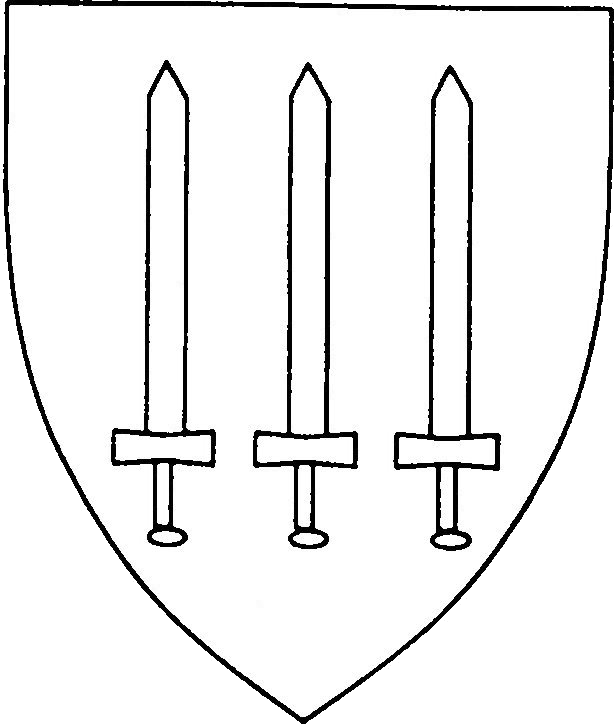
|
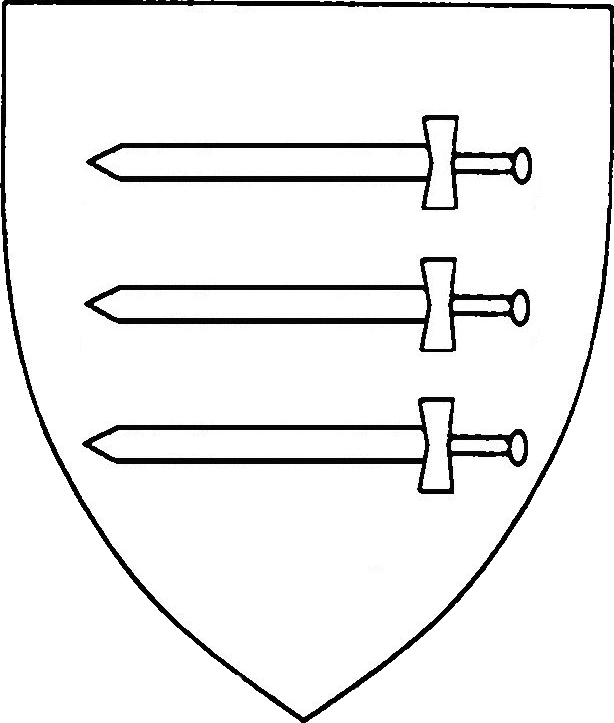
|
Three swords palewise in fess |
Figure 6 |
Three swords fesswise in pale |
To pull these precepts together, let's blazon a specific example, illustrated in fig.7. We start by arranging the elements in the correct order, according to the grammar of heraldry:

|
Figure 7 |
Field: Argent. Primary charge: A bend sable. Secondary charges: In chief, a mullet sable; in base, a lozenge sable. Tertiary charges: On the bend, a roundel argent, an annulet argent, and another roundel argent. Peripheral secondary charge: A chief wavy sable. Peripheral tertiary: On the chief, a sword argent.
We now have the correct order for the blazon. We could string these together, with a few descriptive phrases, and have a workable blazon: Argent, a bend sable, in chief a mullet sable and in base a lozenge sable, on the bend a roundel argent, an annulet argent and a roundel argent, a chief wavy sable and on the chief a sword argent.
While this blazon would work, it isn't very good style. It repeats tinctures too often, it mentions the bend and the chief more than once, and it ignores the order in which charges are listed (chief to base for the secondaries, center outwards for the tertiaries).
Also, we can use particles like on and between, which help simplify the blazon. (The drawback is that we can no longer add the type of amendments the Grandison family used. This is the main difference between medieval and modern blazon. Fortunately, in the SCA, we don't worry about cadency that much, and we have word processors to make blazon amendments simple.)
Dropping the redundancies, and using the particles mentioned above, the blazon becomes: Argent, on a bend between a mullet and a lozenge sable, an annulet between two roundels argent, on a chief wavy sable a sword argent. The result is more concise, and better style.
This brings us to the question of blazoning style. Style has changed from century to century. For
instance, two 13th Century blazons (updating the spelling a bit) might be Argent, a fess sable and
three bezants and Argent, a fess sable and three torteaux. Though the word order is the same, the
roundels are placed differently (fig.8). The medieval herald was expected to apply the Rule of Tincture
to the blazons, and understand that gold charges couldn't possibly be on an argent field, nor red charges
on a black fess. (A number of heraldic scholars of the early 20th Century, notably Oswald Barron and
William St.John-Hope, have advocated a return to this simple style of blazonry; but it only really works
for a simple style of heraldic design. For most modern emblazons, including most SCA emblazons, it
just isn't detailed enough.)
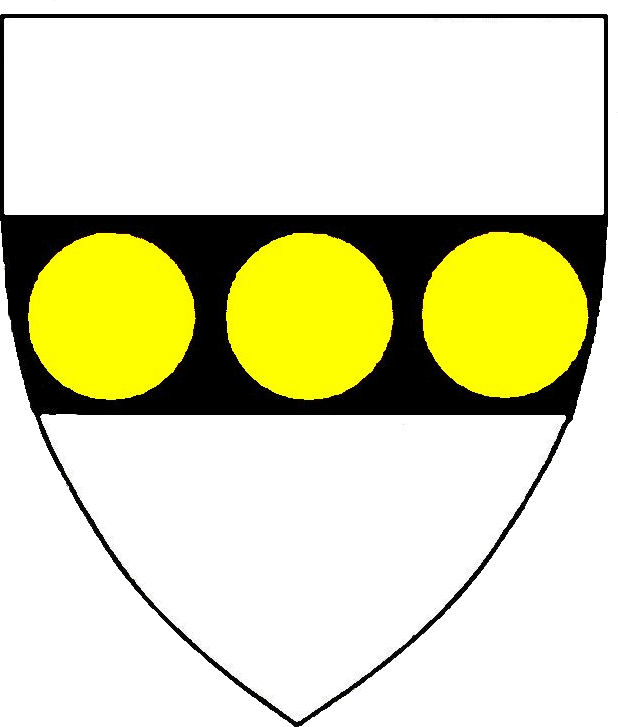
|

|
Argent, a fess sable |
Figure 8 |
Argent, a fess sable and three |
There have also been a few stylistic fads, which were mercifully brief. One was the substitution of jewel-names for the heraldic tinctures: "ruby" instead of "gules", "sapphire" instead of "azure", "diamond" instead of "sable", etc. This fad actually appears to have started in period: a German grant of arms from 1458 uses these terms. As its sole purpose was to obscure the blazon and give it "significance", it is not employed in SCA heraldry.
Even worse was the fad, around the turn of the 17th Century, of substituting the names of the planets for the heraldic tincture. At the time, after all, there were seven of each; surely that could be no mere coincidence. Thus "Mars" was used instead of "gules", "Sol" instead of "Or", "Luna" instead of "argent", "Saturn" instead of "sable", etc. It was felt by the heraldic writers of the time that such heavenly blazonry should be reserved for the highest nobility. Thankfully, this heraldic aberration died out (probably about the time they were discovering new planets, which ruined the symmetry of the scheme).
Still found in mundane blazons are conventions left over from Victorian times. Those blazoners tried to avoid the appearance of tautology, but at the expense of clarity and succinctness. Thus, instead of repeating a tincture, they would use such phrases as "of the field" or "of the third", the latter referring to the third tincture already mentioned. Similar phrases might refer to number or type of charge. Thus a device we might blazon as Argent, on a fess sable between three mullets gules, three annulets argent, a chief gules would be blazoned in a Victorian style as Argent, on a fess sable between three mullets gules, as many annulets of the field, a chief of the third. Such profusion of types and tinctures yield a complex blazon even under the best of circumstances; it's silly to further complicate the blazon with reference that require the blazoner to keep count of the tinctures as they are mentioned.
The blazoning style of the SCA College of Arms depends, for the most part, on whoever happens to be Laurel. This is not mere cynicism, but a statement of fact. The same is true, after all, in the English College of Arms. J.P. Brooke-Little, in one of the footnotes to his edition of Fox-Davies' Complete Guide to Heraldry, sums up the situation nicely:
What really constitutes official blazon? Quite simply, it is the minds of the granting Kings of Arms. It is they who blazon arms and who must take responsibility for good or bad blazon. The rest of us can write about what has been done in the past and what we think ought to have been done, but our opinions are chaff before the wind unless we can persuade the King of Arms of the day to adopt our ideas.
In general, the SCA tends to a simpler style of blazon. We avoid obvious Victorianisms; we do not hesitate to repeat a tincture or a number. The idea is to make ourselves understood, not obscure. A few other peculiarities of our system:
-- The tincture "Or" (gold) is always capitalized in SCA blazon, to avoid confusion with the grammatical conjunction. (Modern mundane blazons go even further, and capitalize all the tinctures.)
-- The tincture "ermines" (black with white ermine spots) is blazoned "counter-ermine" in SCA blazonry. This is the translation of the French blazon, and is used to avoid possible typographic error.
-- Following medieval practice, the diminutive terms for the ordinaries ("bendlet", "bar", etc.) do not mean the ordinary is to be "drawn skinny". Instead, such terms are used when there are more than one of the ordinary (three bars) or when the visual importance is reduced (a bendlet enhanced). The width of the stripes does not affect the blazon: one horizontal stripe is always a fess, and three of them are blazoned three bars, no matter how wide or skinny they happen to be.
-- The engrailed line of partition, when applied to the field, does not seem to follow the mundane default; the references disagree on exactly what that mundane default is. In SCA blazon, Per fess engrailed has its points to chief (fig.9); similar defaults hold for Per bend engrailed, Per chevron engrailed, etc. Invected lines have their points to base by SCA default.

|
Figure 9 |
-- SCA blazonry uses "inverted" to describe a charge turned upside-down, and "reversed" for a charge turned to face sinister. (Mundane blazonry uses "reversed" in the way we use "inverted". I don't know how the SCA system originated.) "Contourny" and "turned to sinister" may also be used in lieu of "reversed", if one wishes to avoid the confusion.
Our goal is not just to blazon, but to blazon well. The essence of good blazon style is threefold:
1. The blazon must be accurate. All necessary details should be blazoned. The type of charge, its posture, its tincture -- anything, if not the default, that counts for heraldic difference must be specified.
2. The blazon must be unambiguous, unequivocal. The purpose of the blazon, after all, is to make possible the reconstruction of the emblazon. Ideally, a blazon should be capable of only one interpretation. A blazon that may be interpreted in more than one way is fatally flawed.
Some emblazons may be blazoned in more than one way: A griffin segreant is the same as a griffin rampant, and one may have three bendlets sinister or three scarpes with equal ease. Such choices are usually governed by the submitter's preference, or that of the submitting herald. In other cases, a distinction can be made worth no heraldic difference, but which influences the heraldic artist: a shamrock vs. a trefoil, or an acorn slipped and leaved vs. an oak slip fructed. One must gauge from the submitter's intent.
3. The blazon should be elegant, euphonious. The blazon should be beautiful, as everything about
heraldry should be beautiful. This is less important than the other two rules: if we must sacrifice
elegance for precision, so be it. But if a blazon can be both accurate and elegant, so much the better.
Everyone has his own standards of elegance, of course. Yours probably differ from my own. But since I'm the one writing this article, let me end it with some of my own preferences:
-- A blazon should avoid tautology, if possible. Sometimes it isn't possible; in that case, repetition is better than inaccuracy.
-- The blazon should be simple and concise. Bloodcurdling overprecision is worse than unnecessary: it is actively distracting, and the effect is non-medieval. Medieval blazons gave no more details than were needed; SCA blazons should do the same. Blazoning a certain sword as "a Turkish cavalry sword from the Abbisid dynasty"is not nearly as elegant as blazoning it, simply, as a "shamshir".
In like manner, the exact anatomical details of animals should be omitted. "Armed", "langued", "orbed", "crined", "pizzled"and all the rest are mere superfluities. Artistic details should be left to the license of the artist.
-- Defaults should be used when convenient. They help keep the blazon short, and help reinforce period design.
-- I'm of two minds regarding the use of medieval terms in SCA blazon. On the one hand, we are a medievalist group, and should at least try to use the medieval terms: coney rather than rabbit, reremouse rather than bat, camelopard rather than giraffe. On the other hand, sometimes a medieval term can be so obscure that its meaning is lost: Party per graft seems to have been a medieval term for Per chevron, and en l'un de l'autre (one into the other) was the medieval form of counterchanged. Such terms are too obscure for our purposes, especially as well-known alternatives exist. (On occasion, a term is invented by a heraldic writer and is used by no one else. The effect is the same.)
The exception to this is for canting arms. Cants were so commonly used in medieval armory that they should be encouraged in SCA armory -- even if it means using an obscure term for a charge. A submitter named Iain Scrogie may be forgiven for blazoning a tree branch as a "scrog".
-- Anglicized terms seem better to me than their French originals. Why use gouttée when goutty will do as well? (Better, in fact, if one doesn't have access to diacritical marks) I simply prefer affronty rather than affronté, bretessed rather than bretessé, checky rather than checqué, etc. That's just me, of course.
-- A great many blazons can be simplified by using active, rather than passive terms. A ship, sail unfurled and facing sinister is passive; a ship sailing to sinister is active, with the same picture in fewer words. A savage maintaining over his head a club bendwise inverted is passive and awkward; a savage brandishing a club is active, concise, and avoids over-blazoning the club.
The best sources for good blazon are the blazons of medieval armory. If you can get a copy of the Rous Roll, for instance, it lists a great many period blazons. Gerald Brault's Early Blazon: Heraldic Terminology in the Twelfth and Thirteenth Centuries is a definitive reference; but be prepared to learn Old French, you'll need it with this book. Most heraldry texts (e.g Boutell, Fox-Davies) have primers on the grammar of blazon, and give enough examples to let you see how it's used. Most important is practice. Like any foreign language, practice is essential. Good blazon is not beyond anyone's capability. Good luck!
Originally printed in the proceedings of the Calontir Heraldic Symposium, 1988.
Originally webbed by Dafydd Wolfson / dafydd@dnaco.net
The heraldry.sca.org site is copyright 1995-2024 Society for Creative Anachronism, Inc. The copyright of certain portions of heraldry.sca.org are retained by the original contributors as noted.
External links are not part of the heraldry.sca.org web site. Inclusion of a page or site here is neither implicit nor explicit endorsement of the site. Further, SCA, Inc. is not responsible for content outside of heraldry.sca.org. For information on how SCA uses collected and submitted data, please see the Privacy Policy.
Paper texture used with permission from GRSites.com.